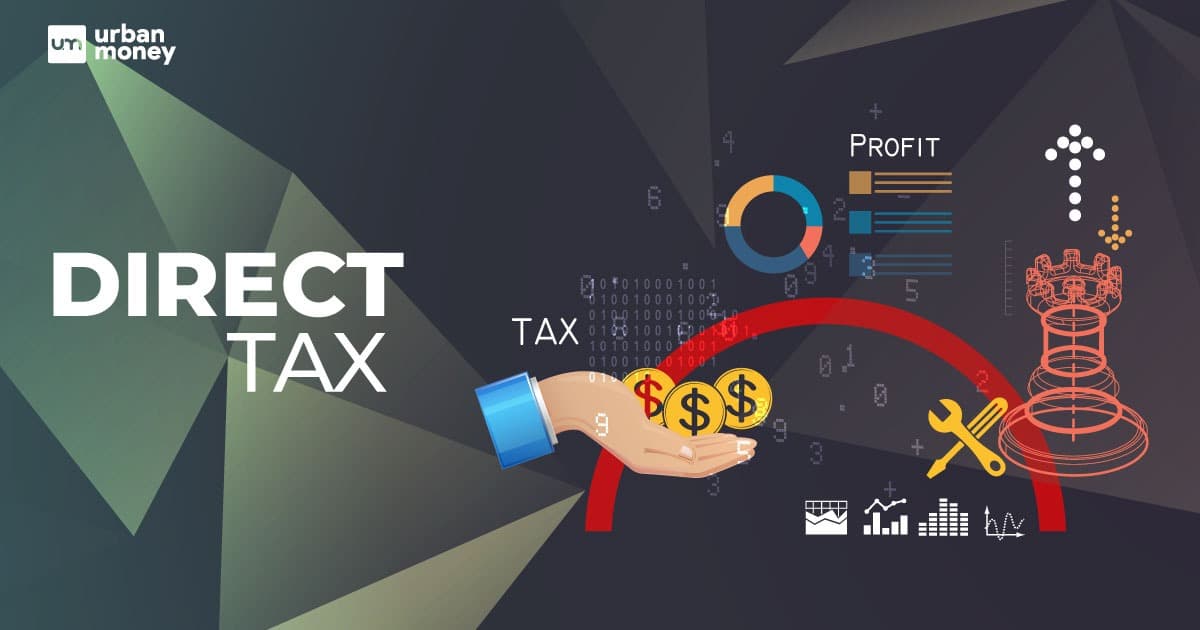- Home
- Income Tax
- Direct Tax
Direct Tax

- Personalized solutions
- Expert guidance
- Application assistance
- Credit score discussion
- Interest rate comparison


Last Updated: 27 December 2025
Direct tax is a type of tax wherein the prevalence and effect of taxation fall on the same entity. In India, direct taxes are imposed by the central government and include taxes on income and wealth. Direct taxes are important revenue sources for governments at all levels and are generally progressive; higher-income taxpayers pay higher tax rates. This makes direct taxes a vital tool for reducing income inequality. These taxes are levied on individuals, corporate entities, and other organizations.
The major types of direct taxes in India are income tax, corporate tax, and wealth tax. It’s important to note that direct taxes (income tax) are usually paid in proportion to what is earned. This includes taxes on income, property, and other possessions. The Central Board of Direct Taxes (CBDT), a body under the Ministry of Finance, administers direct taxes.
Types of Direct Taxes
We often hear about indirect taxes in the news, but there is a lot of confusion regarding direct taxes. We usually do not know which taxes fall into this category. At the same time, direct taxes are what we pay when we make earnings from any source of income. There are several types of direct taxes that the government levies. These taxes are collected directly from taxpayers and are used to fund government operations. The most significant types of Direct Taxes are outlined below:
Income Tax:
Income tax is a tax that is levied on the income of individuals and businesses. The income tax is progressive, meaning the higher the income, the higher the tax rate. The Income tax is broadly categorized into five heads, i.e., income from salary, income from house property, income from capital gains, income from profits and gains of business and profession, and income from other sources.
The income tax is used to finance the government’s expenditure on public goods and services like infrastructure, healthcare, education, and other social welfare programs. The government has set up a dedicated website for filing income tax returns, which makes it convenient for taxpayers.
Wealth Tax:
The taxpayer is liable to pay wealth tax on an annual basis concerning the market value of the property owned. If an individual owns the property, they must pay wealth tax irrespective of whether the estate generates income. On the other hand, in the HUF (Hindu Undivided Family), corporate taxpayers’ eligibility to pay wealth tax is with respect to the residential status of the property.
Estate Tax:
The estate tax, also known as inheritance tax, is based on the market valuation of the asset one has left after death/demise.
Income From Salary
A salary is an individual’s remuneration received or accrued periodically for service rendered under an express or implied contract. In terms of taxability, the actual salary receipt in the previous year is not material.
Income From House Property
The annual value of an assessee’s property, whether it is a building or land appurtenant thereto, is taxable under the heading “income from house property.”
Income From Capital Gains
In India, capital gains are the profits generated by the sale of a capital asset, such as land, shares, or a residence.
| Type of Capital Gains | Parameters | Tax Liability |
| Long-term capital gains | Exception: Sales on equity shares/ unit of equity-oriented funds | 20.00% |
| Long-term capital gains | Sales on equity shares/ unit of equity-oriented funds
|
10.00% over and above INR 10 lakhs |
| Short-term capital gains | When STT is not applicable | The gains are added to your ITR, and the taxpayer is taxed according to your income tax slab rates |
| Short-term capital gains | When STT is applicable | 15.00% |
Income From Profits and Gains of Business and Profession
The term “business and professional income” refers to any income that results from business operations. This category also includes freelancer income. In a nutshell, it is the company’s net profit or loss.
Income From Other Sources
The fifth and last head of income is income from other sources. Income from other sources includes any source of income that doesn’t fall under any additional taxation charges.
Corporate Tax
The corporate tax is a tax levied on the income of corporations. The tax is imposed on the profits earned by the corporation and is typically based on a percentage of the corporation’s total revenue. The tax is also used to finance the government’s regulatory activities, such as enforcing environmental and safety regulations. Companies are taxed at a rate of 30% on their profits. However, several deductions and exemptions can lower this rate. The corporate tax system in India is constantly changing, so it’s essential to stay up to date with the latest rules and regulations.
| Sections | Tax Rate | Surcharge |
| Section 115BA | 25% | 7% or 12% |
| Section 115BAA | 22% | 10% |
| Section 115BAB | 15% | 10% |
| In any other case | 30% | 7% or 12% |
In the case of Foreign Companies
| Nature of Income | Tax Rate |
| Royalty received/ fees for technical services from the Indian government or any Indian concern under an agreement made before 1st April 1976 and approved by the central government | 50.00% |
| Any other income | 40.00% |
Additional Tax Rates
| Particulars | Tax Liability |
| If total income exceeds INR 1 crore but less than INR 10 crores | ● 7% of the tax calculated on a domestic company
● 2% of the tax calculated in a foreign company |
| If total income exceeds INR 10 crore | ● 12% of the tax calculated on a domestic company
● 5% of the tax calculated in foreign company |
Securities Transaction Tax
Security transaction taxes (STTs) are taxes levied on securities transactions. STTs are applied on transactions, not on securities themselves. Moreover, taxes are levied on sellers, not buyers. In most cases, the seller pays the tax as a percentage of the transaction value. STTs are levied on equity shares and debt instruments at 0.15% and 0.025%, respectively, to generate revenue for the government and curb speculative trading.
There has been controversy regarding STT, with some arguing that it should be imposed on both the buyer and seller. Some argue that the law should apply only to the seller when it comes to the sale of securities. There is also a debate on the rate of STT, with some arguing that it should be increased to 0.3% for equity shares and 0.1% for debt instruments.
| Taxable Securities | Rate | Value on which STT To Be Paid |
| Delivery-based purchase of equity shares | 0.1% | Price at which equity share is purchased* |
| Delivery-based sale of equity shares | 0.1% | Price at which equity share is sold* |
| Delivery-based sale of oriental mutual funds | 0.001% | Price at which unit is sold* |
| Sale of equity share or unit of equity-oriented mutual fund in a recognised stock exchange otherwise than by actual delivery or transfer and intra-day traded shares | 0.025% | Price at which equity share or unit is sold* |
| Derivatives: sale of an option in securities | 0.017% | Option premium |
| Derivative – Sale of an option in securities where option is exercised | 0.125% | Settlement price |
| Derivative – Sale of futures in securities | 0.01% | Price at which such futures is traded |
| Sale of unit of an equity-oriented fund to the Mutual Fund – Exchange-traded funds (ETFs) | 0.001% | Price at which unit is sold |
| Sale of unlisted shares under an offer for sale to the public included in IPO, and where such shares are subsequently listed in stock exchanges | 0.2% | Price at which such shares are sold |
| Purchase of oriental mutual funds | NIL | N/A |
Tax Rate for the Different Types of Direct Tax
An income tax slab of a taxpayer is determined by the age and salary of an individual. The following are the three income tax slabs:
Individuals and HUFs under the Age of 60
| Tax Slab | Income Tax |
| Upto Rs 2.5 Lakhs | Nil |
| Rs 2,50,001 – Rs 5 Lakhs | 5% of the Total Income that more than 2.5 Lakhs Plus 4% cess |
| Rs 5,00,001 – Rs 10 Lakhs | 20% of the total income that is more than Rs 5 Lakhs along with Rs 12,500 plus 4% cess |
| Income Above Rs 10 Lakhs | 30% of the Total income that is more than Rs 10 Lakhs plus Rs 1,12,500 plus 4% cess |
Senior Citizens from the Age of 60 to 80 years.
| Tax Slab | Income Tax |
| Upto Rs 3 Lakhs | Nil |
| Rs 3,00,001 – Rs 5 Lakhs | 5% of Income that is more than 3 Lakhs plus 4% cess |
| Rs 5,00,001 – Rs 10 Lakhs | 20% of the Income that is more than Rs 5 Lakhs plus 4% cess along with Rs 10,500 |
| Income Above Rs 10 Lakhs | 30% of the Income that is more than Rs 10 Lakhs plus 4% cess along with Rs 1,10,000 |
Super Senior Citizens (Senior Citizens above the age of 80)
| Tax Slab | Income Tax |
| Upto Rs 5 Lakhs | Nil |
| Rs 5,00,001 – Rs 10 Lakhs | 20% of the Income that is more than Rs 5 Lakhs plus 4% cess |
| Income Above Rs 10 Lakhs | 30% of the Income that is more than Rs 10 Lakhs plus 4% cess along with Rs 1,00,000 |
New Income Tax Slab for Individuals
The following table showcases the New Income tax slab introduced by the Government for Individuals.
| Income Tax Slab | Tax Rate |
| Upto Rs 2.5 Lakhs | Nil |
| From Rs 2,50,001 to Rs 5,00,000 | 5% of the total amount more than 2.5 Lakhs plus 4% cess |
| From Rs 5,00,001 to Rs 7,50,000 | 10% of the total amount more than Rs 5 Lakhs plus 4% cess |
| From Rs 7,50,001 to Rs 10,00,000 | 15% of the total amount more than Rs 7.5 Lakhs plus 4% cess |
| From Rs 10,00,001 to Rs 12,50,000 | 20% of the total amount more than Rs 10 Lakhs plus 4% cess |
| From 12,50,001 to Rs 15,00,000 | 25% of the total amount more than Rs 12.5 Lakhs plus 4% cess |
| Income above 15,00,001 | 30% of the total amount more than Rs 15 Lakhs plus 4% cess |
Explanation of The Direct Tax Codes
The following features explain the Direct Tax Codes:
- The Direct Tax code brings all the different types of direct taxes under a single code. All the compliance can be unified under this one direct tax code.
- Under the Direct tax code, the rate of taxes is set between the first and fourth schedules of the DTC. This provides stability as the government can make necessary changes in the schedule through an amendment passed in the parliament.
- Elimination of all the other regulatory functions.
- The Direct Tax code allows 5% of the total gross income towards political contributions.
- The law has been drafted to stimulate the economy’s growth without any hindrance to constantly changing the amendment.
Advantages of Direct Tax
Direct taxes are primarily perceived as fairer than indirect taxes, such as the GST. This is because direct taxes are levied on individuals according to their ability to pay, while indirect taxes are levied on everyone regardless of their income.
| Effective and Efficient
Direct taxes are the most efficient and effective way to collect revenue in India. They are easy to administer and gather and provide a stable revenue source for the government. |
| Lower Rate of Interest
Compared with indirect taxes, they provide a higher rate of tax collection because they are paid directly from the person being taxed instead of from the entire economy. These taxes tend to be borne by the individual and therefore result in enhanced compliance and increased direct government spending. |
| Progressive in Nature
Direct taxes are also progressive, meaning that they place a more significant burden on higher-income earners. This helps to reduce income inequality and can be used to fund social welfare programs. |
| Accurate Assessment
Direct taxes are advantageous because they provide an accurate assessment of an individual’s income. This allows for a more precise tax calculation than if you were to use indirect taxes. Therefore, there are fewer errors and more accurate assessments. |
| Discourages Non-Compliance
Direct taxes are also an excellent way to discourage non-compliance. Because of their direct connection to personal income, there is a strong incentive for people to pay their taxes on time and accurately. Furthermore, individuals who receive a large portion of their income through wages have a significant incentive to pay their fair share. This is due to the amount of money they will lose if they do not. |
What is Indirect vs Direct Tax?
Both direct and indirect taxes are essential sources of revenue for the government. However, there are some critical differences between the two.
Indirect taxes are levied on goods and services purchased, while direct taxes are imposed on income and wealth. As a general rule, direct taxes are paid directly to the government, while indirect taxes are delivered to the seller.
Direct taxes are usually progressive, meaning that the more income or wealth you have, the higher your tax rate will be. Indirect taxes, on the other hand, are typically regressive, meaning they take up a more significant percentage of income for low-income earners than high-income earners.
Direct taxes are typically more stable than indirect taxes, as they are not as affected by economic fluctuations. Indirect taxes, however, can fluctuate significantly depending on the level of economic activity.
Overall, both direct and indirect taxes play their own part in funding government operations. However, the key differences between the two should be considered when making tax policy decisions.
History Of Indian Direct Tax
The history of Indian direct taxes can be traced back to the Vedic period when tariffs were imposed on agricultural produce. During the Mughal period, a taxation system was introduced whereby farmers were required to pay a tax percentage on their crop production. However, the British later abolished this system during the colonial period. Instead, they imposed a direct tax on land revenue in 1757. This was followed by taxes on income and expenditure in 1792 and taxes on salt and opium in the 19th century.
After India gained independence in 1947, the Direct Tax Code was introduced in 1948. The Income Tax Act replaced this in 1961. The current Direct Tax Code was introduced in 2010. The Direct Tax Code is constantly updated to keep pace with the changing economy.
Direct taxes are an essential source of revenue for the Indian government. They are used to finance a variety of government programs and services. Its progressive nature states that the rich are taxed at a higher rate than the poor. This helps to reduce inequality in society.
The government has set up several tax exemptions and concessions for certain sections of society, such as senior citizens and women.
| Related Resource |
| Deductions Under Section 80C |
| Income Tax Slabs and Rates |
| Income Tax Refund Status |
| Income Tax e-filing |
| ITR – Income Tax Return |
FAQs
What is direct or indirect tax?
Direct taxes are levied on income and wealth, while indirect taxes are levied on the purchase of goods and services. Direct taxes are typically paid directly to the government, while indirect taxes are paid to the seller of the goods or services.
What are the rules relating to taxation of gifts?
Gifts received by any person or persons are taxed in the hands of the recipient under the head ‘Income from other sources’ at normal tax rates.
What is TDS?
TDS is the amount of tax which is deducted by the employer or deductor from the taxpayer and is deposited to the Income Tax Department on behalf of him/her.
What is the disadvantage of Direct taxes?
The amount paid under direct taxes is usually high and pinching to the taxpayer. This leads to tax evasion.
